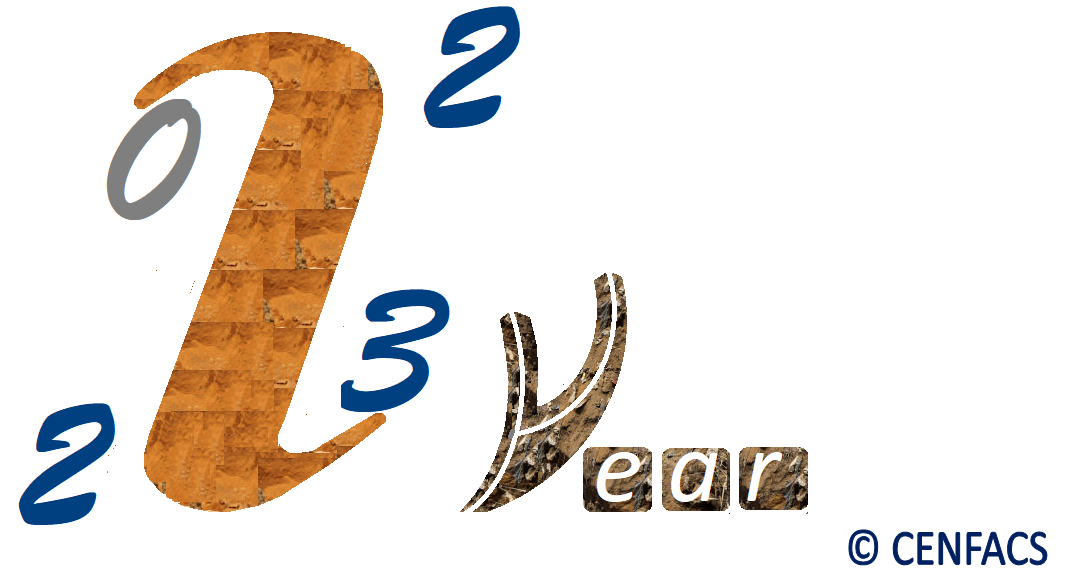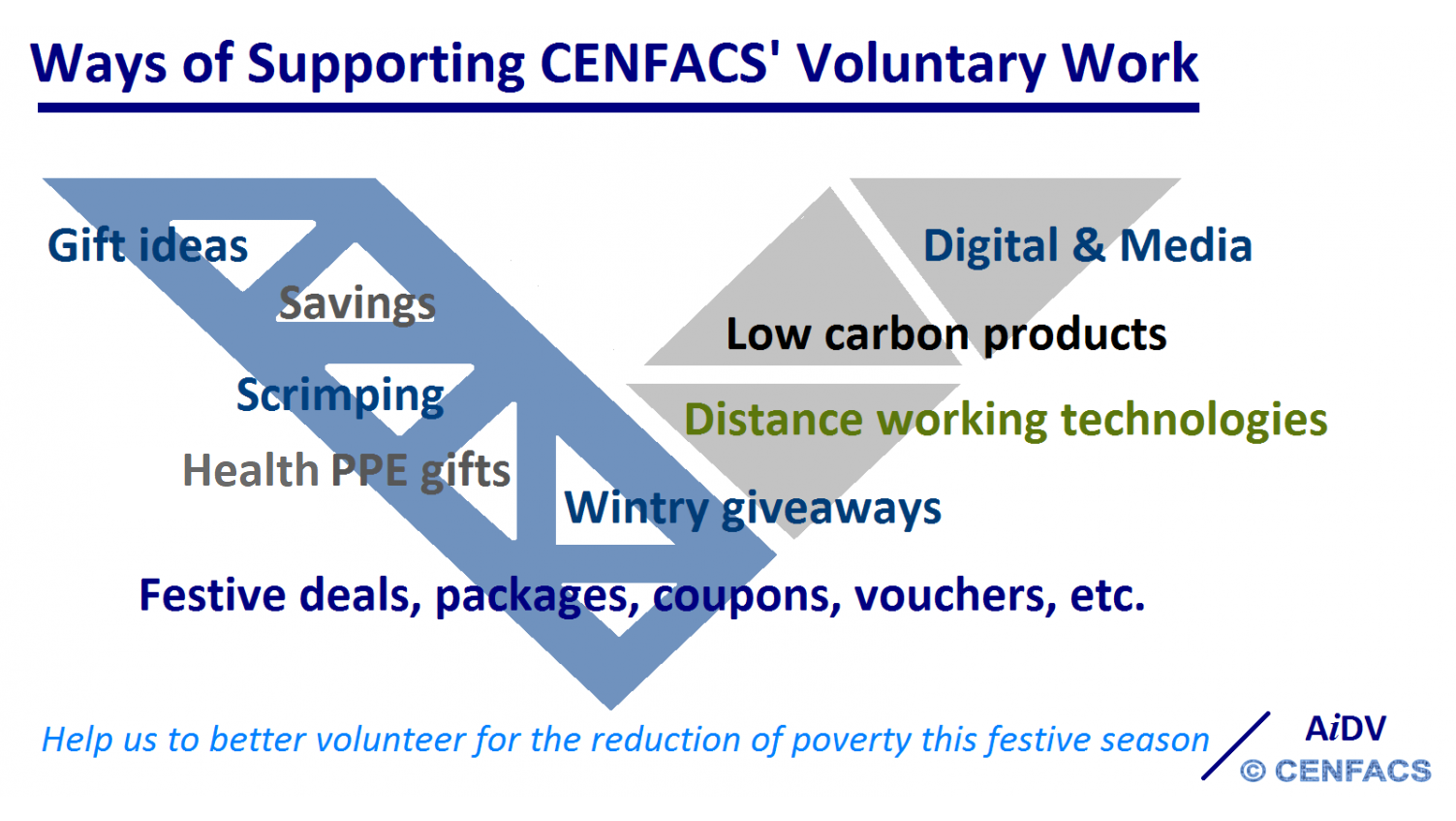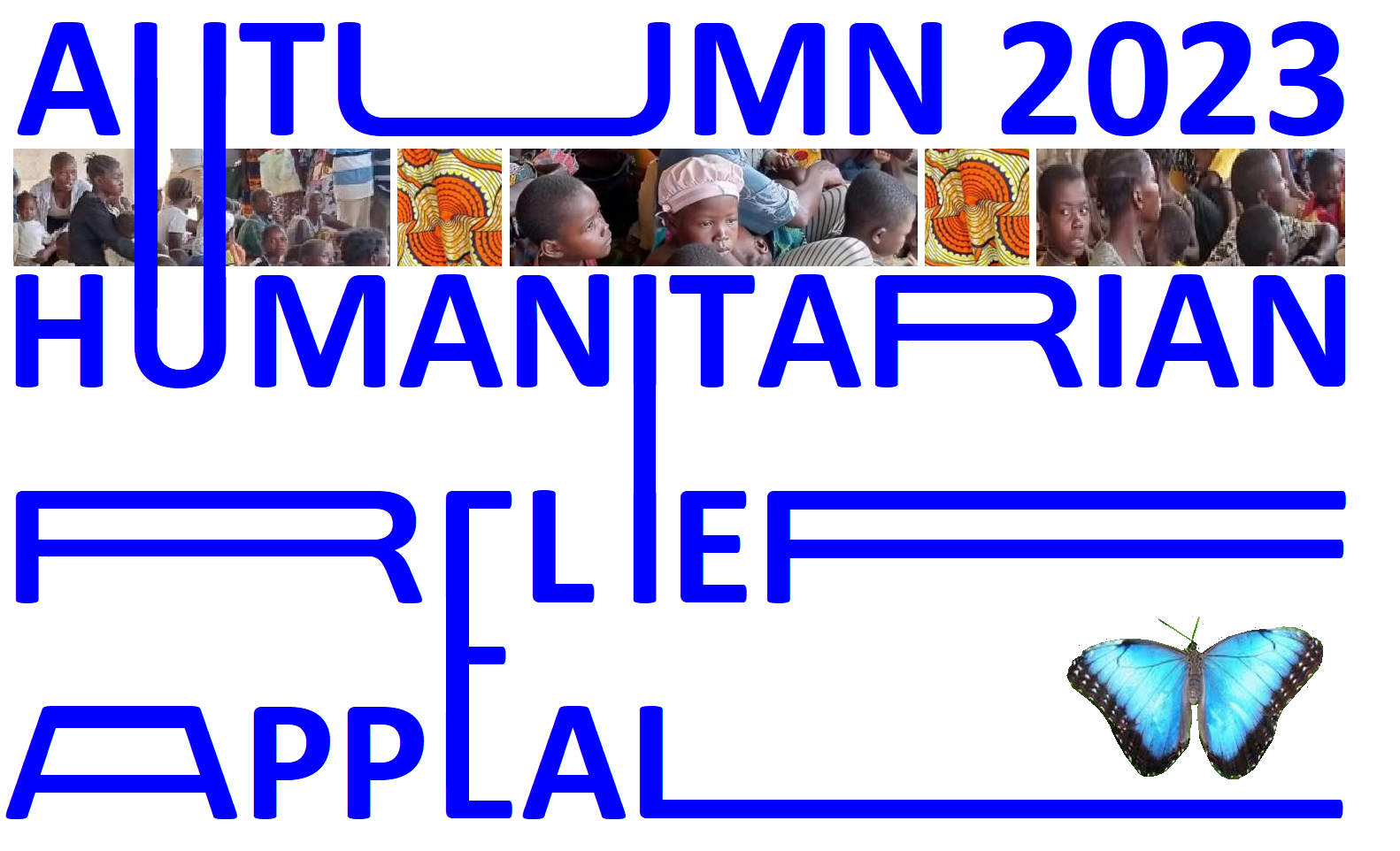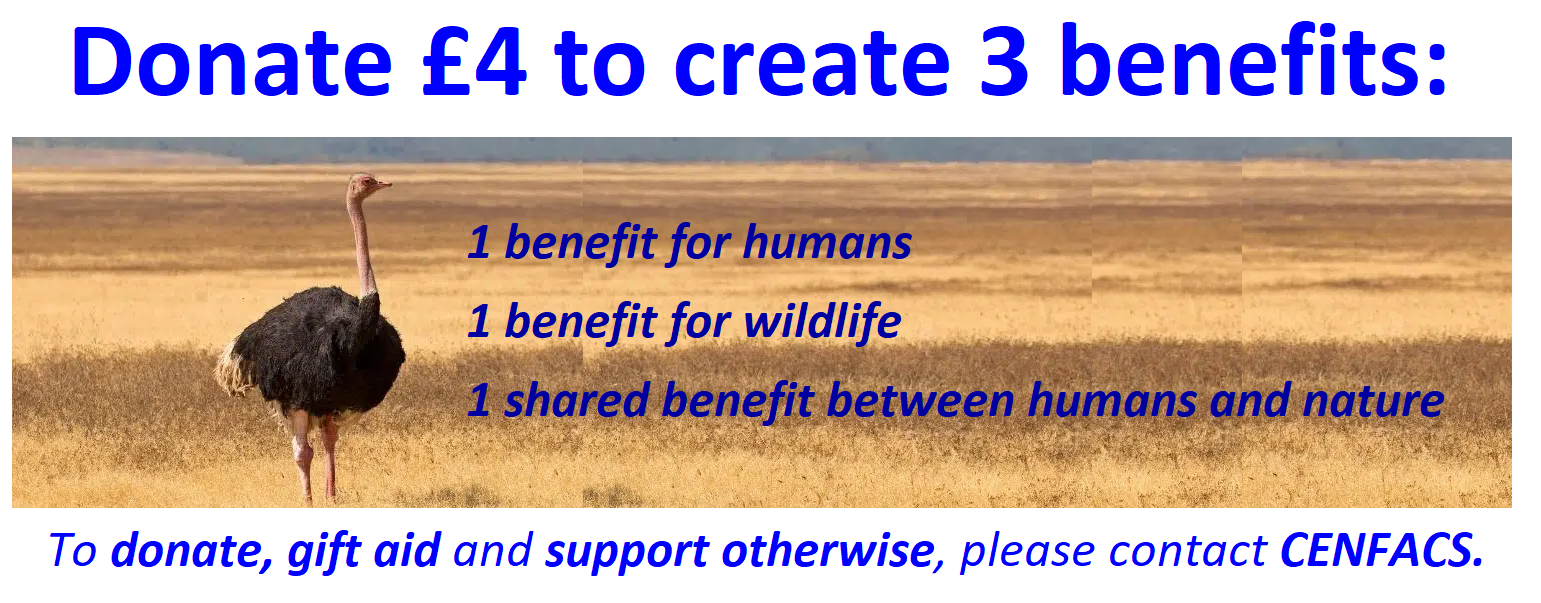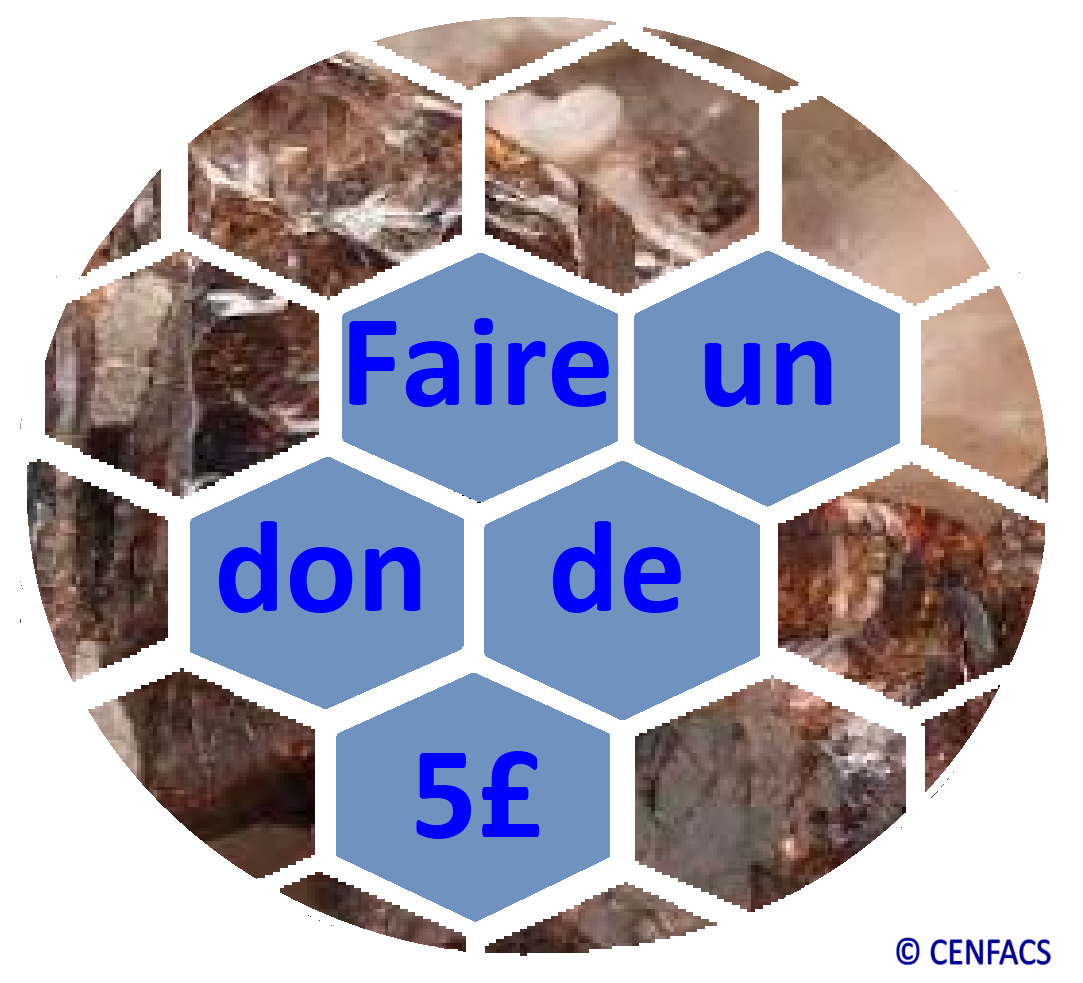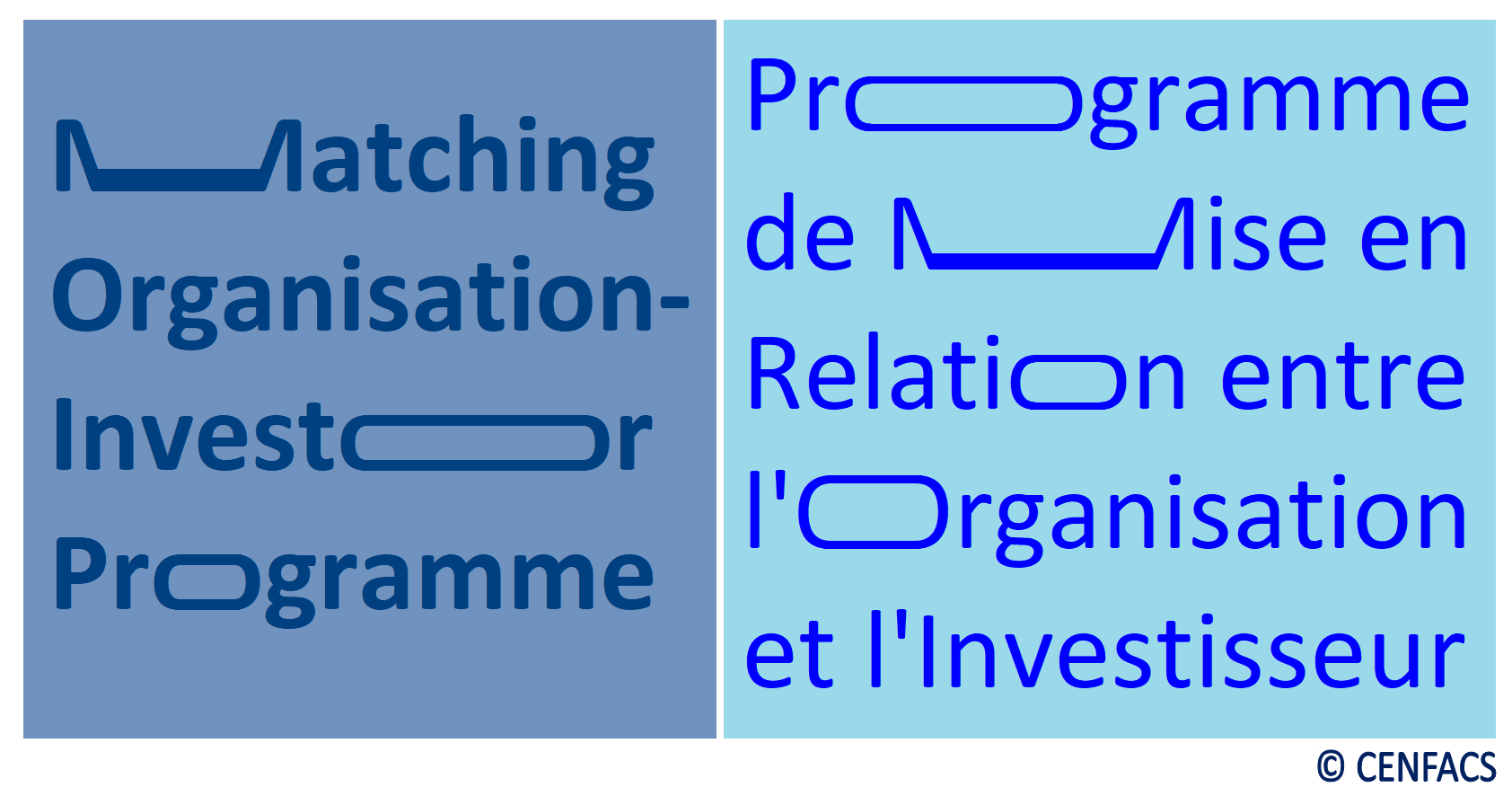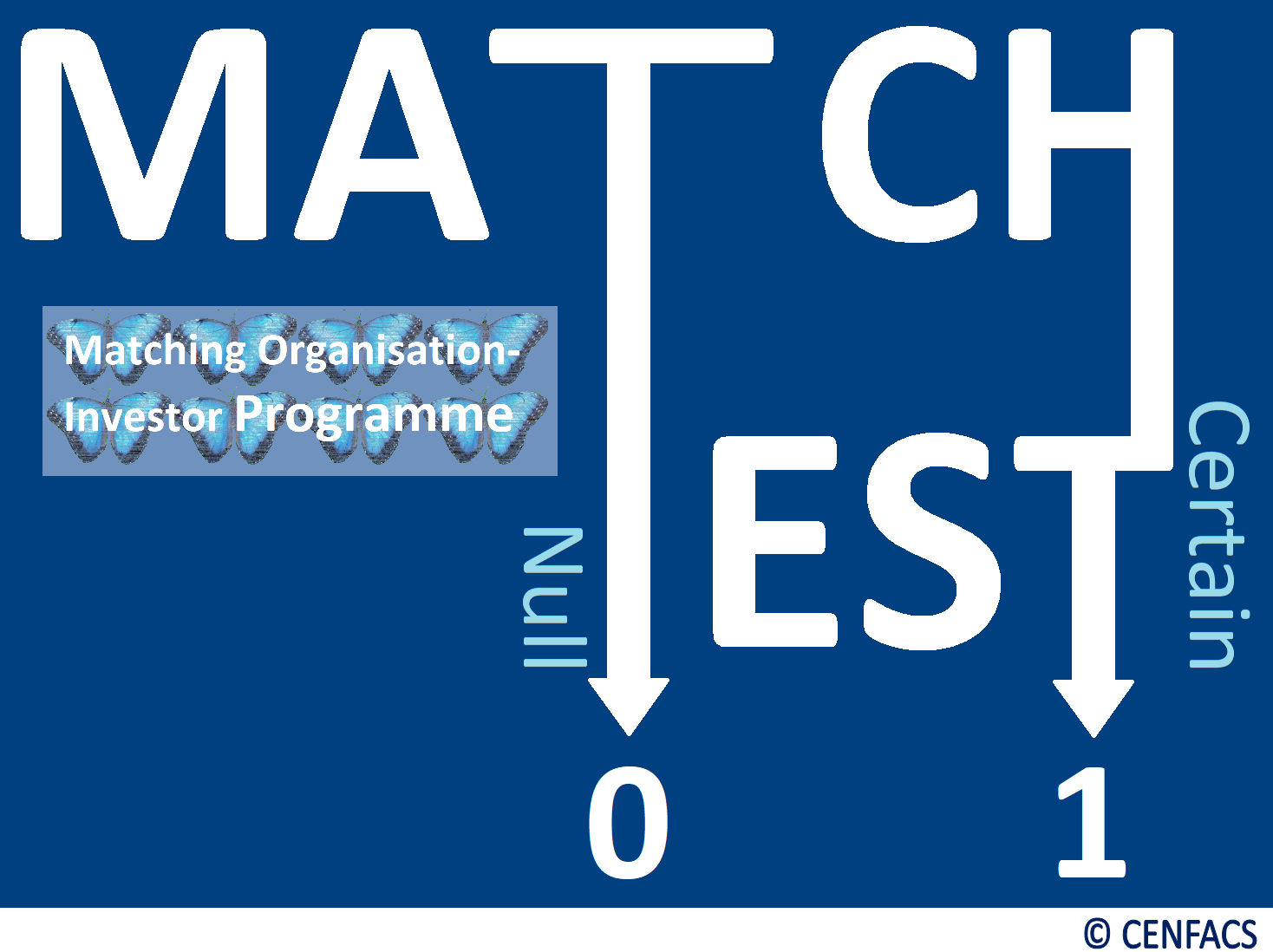Welcome to CENFACS’ Online Diary!
13 December 2023
Post No. 330
The Week’s Contents
• Matching Organisation-Investor Programme – Activity 4 (from 13 to 19/12/2023): Matching Organisation’s Project Documentation with Investor’s Pre-investment Evaluation and Capitalizing on Evaluation
• Translating or Turning the Goal of the Festive Month into the Gift of the Festive Month
• E-discussing Volunteering for Poor People and the Planet and Supporting All in Development Volunteer Scheme (AiDVS)
… And much more!
Key Messages
• Matching Organisation-Investor Programme – Activity 4 (from 13 to 19/12/2023): Matching Organisation’s Project Documentation with Investor’s Pre-investment Evaluation and Capitalizing on Evaluation
The last episode of our 4-week Matching Organisation-Investor Programme is about Matching Organisation’s Project Documentation with Investor’s Pre-investment Evaluation and Capitalizing on Evaluation.
Indeed, both parties (i.e., Africa-based Sister Charitable Organisation and Not-for-profit Investor) have made progress so far as they continue to score points; points which are enough to enable them to enter the last stage of the matching talks. They are excited and have started to dream to begin 2024 with a new investment for Africa-based Sister Charitable Organisation (ASCO) and a new asset in portfolio for not-for-profit (n-f-p) investor. However, each of them still has some work to do to complete the matching process.
For ASCO, this Activity 4 is about having its application for investment in the form of project documentation. This application needs to be completed and to show coordination and collaboration in terms of its contents.
This last stage is an opportunity for ASCO to elevate its application in line with project planning theories, processes and practices. It is the stage at which ASCO has to sell its project unique point to stand out amongst competing projects and organisations, while highlighting impactful aspects of its project in terms of poverty reduction.
As to the n-f-p investor, it is about keeping its pre-investment evaluation ready while capitalising on the findings from this evaluation in order to win an organisation in which to invest. In its pre-investment evaluation, n-f-p investor will look at qualitative (facts) and quantitative (numbers) data, metrics and indicators to help him/her in its investment decision or case. This insight will indicate to him/her whether or not to back the project and the ASCO that initiates this project.
Where the two (i.e., investee and investor) need support, CENFACS will work with each party to fill the gap.
More on Activity 4 can be found under the Main Development section of this post.
• Translating or Turning the Goal of the Festive Month into the Gift of the Festive Month
Our Goal for the Festive Month is about Reducing Income Poverty for the Income Poor. Our Gift for the Festive Month is a donation of £5 to support income poor. In this respect, it is possible to translate or turn of our Goal for the Month into a Gift for the same month. Before turning it, let us explain this goal.
• • Goal for the Festive Month: Reduction of Income Poverty for the Income Poor
Our goal for the festive month is about reducing income poverty since we are in Income Generation Month within CENFACS. This goal has a target or a result that aims to achieve.
For instance, our goal for the income generation month could be to make sure that the members of our community have enough income to cover their basic expenses, pay off debts and save for emergencies. The target could be how many of them can realistically achieve this goal. The target could be as well the level or seize of income (e.g., being at or above the international poverty line) they need to earn or have this month.
The above is our poverty reduction goal and target for this festive month, which we are asking to our audiences and supporters to translate or turn into gift of the festive month.
• • Translating or Turning the Goal of the Festive Month into the Gift of the Festive Month
Any of our supporters can translate or turn the Goal of the Festive Month into the Gift of the Festive Month to support the income poor or project to support these poor via CENFACS.
For instance, one can make a donation of £5 to support income poor to achieve one of the targets below:
√ to build resilience against financial stresses
√ to address financial incapacity and incapability
√ to reduce the financial effects of the high costs of festive living
√ to develop financial life-saving skill and knowledge
√ to improve financial decision-making skills of the financially unskilled poor
√ to contribute to income-generating activities of the income poor.
Your festive gift will help reduce income poverty amongst the income poor and give them some hope for 2024.
To support and/or enquire about the Goal of the Festive Month and to provide the Gift of the Festive Month, please contact CENFACS.
• E-discussing Volunteering for Poor People and the Planet and Supporting All in Development Volunteer Scheme (AiDVS)
Our Winter e-discussion about Volunteering for Poor People and the Planet has entered its third planned area. In this area, the e-discussion is on Volunteering to find resources to support vulnerable people and communities; e-discussion which would be held on 13, 14 and 15 December 2023.
While our Winter e-discussion is going on, we are asking for support to CENFACS’ All in Development Volunteer Scheme (AiDVS).
• • Supporting All in Development Volunteer Scheme (AiDVS)
It is possible to support CENFACS and its AiDVS from wherever you are (at home, work, away, online, abroad, on the go and move, etc.). Supporting us does not need to be magical and majestic. It can be in any thing or means that can advance the work of AiDVS.
Your support will help us to support others who need support during this challenging time.
One can still enjoy a great festive season while supporting us to support others.
There are many simple helpful and useful ways of adding great value to our voluntary work.
Here are 12-themed enhancers or ways of adding great value to CENFACS’ AiDVS:
1) Gift ideas for the best ways of monitoring, evaluating and reviewing projects and programmes in the New Year
2) Money-saving and scrimping tips from scrimpers for AiDVS
3) Festive deals and packages (e.g., seasonal discounts, discount codes, etc.) for AiDVS
4) Festive free coupons, promo codes and vouchers for AiDVS
5) Net-zero or low carbon economic products to protect the environment and nature
6) Digital and media support to better volunteer for a climate neutral and sustainable world
7) Health and safety gifts for healthy and safe volunteering in the New Year
8) Wintry and festive giveaways (e.g., free products, gift cards, free tickets, etc.) to volunteer for a net zero greenhouse gas emissions world
9) Generative Artificial Intelligence volunteering tools to improve the efficiency of volunteering
10) Festive price bundling for flexible volunteering
11) Distance working and gift technologies (e.g., cloud technology, volunteer management software, apps, virtual volunteering tools, etc.)
12) Net-zero energy saving products to volunteer for poor people and the planet.
The above-mentioned enhancers, which could be wintry and festive news, information and products – will assist volunteers (that is, short-term, episodic, regular ongoing and virtual volunteers) to better help out CENFACS’ noble cause of poverty reduction. They will also assist in recruiting and easily managing volunteers while improving volunteer experience and the effectiveness of our work on poverty reduction. Additionally, they will contribute in tracking volunteers and their work.
For instance, gift technologies could enable to automate volunteers’ tasks to free up resources and time as well as increase volunteer engagement in our poverty reduction work.
To support AiDVS with your wintry or festive gift, please do not hesitate to contact CENFACS.
To e-discuss Volunteering for Poor People and the Planet, please communicate with CENFACS.
Extra Messages
• Influence Year and Project: Impact Monitoring and Evaluation
• Autumn 2023 Humanitarian Relief Appeal: Only One Week to Go!
• Festive Structured Finance Activities/Micro-projects under Financial Capacity and Capability Building Programme/Scheme
• Influence Year and Project: Impact Monitoring and Evaluation
At the start of 2023, we dedicated 2023 as a Year of Positive Influence to Reduce Poverty within CENFACS (1) and of poor people’s needs and demands; positive influence that would better help work with them so that they can navigate their way to poverty reduction. To deliver this dedication, we set up a Policy Influencing Project or Influence Project.
• • What is Policy Influencing Project or Influence Project or ‘i‘ Project?
The ‘i‘ Project is a series or set of interconnected influencing tasks or activities planned for the execution of CENFACS‘ dedication of year 2023 as of Positive Influence. These tasks or activities, which aim at reducing poverty, were planned to be undertaken all over 2023 within the requirements and limitations of CENFACS‘ existing and acquirable resources, capacities and assets.
Through this project, we did hope to continue to help reduce poverty through the influence on people and factors holding the key to the solutions to problems faced by our potential ‘i‘ project beneficiaries during 2023. In this respect, the ‘i‘ Project was designed to accompany project beneficiaries in their journey to the reduction of poverty and hardships. The ‘i‘ Project has activities and tasks (or 12 Influence Project episodes).
• • Activities and Tasks Relating to the ‘i’ Project
A number of activities and processes has been conducted each month to enable smooth implementation of the project. We planned twelve specific activities/tasks (or 12 Influence Project episodes), one activity or task every month. Through this project and each task, we have tried as much as we could to identify people who could have influence on poverty reduction generally and on a particular area of poverty reduction (e.g., humanitarian or overseas development matters).
We have used our head, heart and hands to appeal to those who could (i.e., influential figures) to help us help reduce poverty and enhance sustainable development. We have been working to find things or factors that can be influenced so that they could positively contribute to the same goal of relieving need hardship and distress amongst our community members throughout our dedicated year. Last week, we announced the last activity or episode of the Influence Project, while carrying out impact monitoring and evaluation of the same project.
• • Continuing Impact Monitoring and Evaluating the ‘i’ Project
This week, we are continuing the process of looking back what happened in the last 11 months until now. This is our impact monitoring task. Equally, it is worth to start the task of evaluating the Influence Year and Project. We may not finish this evaluation by the end 2023, but it is better to start now and continue it in January 2024 if we do not finish.
The two exercises (i.e., monitoring and evaluation) will enable to inform any interested parties (e.g., project beneficiaries, supporters, our audiences, etc.) the findings about what we did not know and we now know about the needs and aspirations of the people in need making our community. These monitoring and evaluative exercises would also lay ground to seize the early impacts or outputs from the delivery of the Influence Year/Project.
From these exercises – monitoring, evaluative information and knowledge – and other discoveries within the project, we can plan the kinds of appropriate responses we may develop or ways of working together with project beneficiaries in 2024 to meet those unmet needs and demands.
In order to impact monitor and evaluate the Influence (i) Project, it is essential to have a theory of change for accountability and reporting to stakeholders. We had this theory before starting this policy influencing project. The theory of change developed here is the causal chain or a description of a succession or chain of elements and causal connections between them.
For example, one could look at any of the 12 activities/tasks (or 12 Influence Project episodes) and check how they were connected to find out if there were inputs, outputs, outcomes and impacts which each element led to the next.
The Impact Monitoring and Evaluation (IME) will provide the two results below.
On the one hand, the IME will tell if there has been influence in terms of:
~ attitudinal change, that is whether or not the ‘i‘ project has allowed to draw attention, affect awareness, attitudes and perceptions of the poor
~ procedural change, that is changes in way poor people decide their matters
~ behaviour change, that is changes in behaviour in poor people.
On the other hand, we can evaluate if the activities (e.g., lobbying, negotiation, advocacy, etc.) conducted influenced policy or policy content change.
For example, can we argue that our influencing appeals (like the Polycrisis-impacted Children of East Africa Need Your Influence Right Now, Africa’s Food Crisis Impacted Need Your Influence, Libya-Morocco Joint Influence Appeal, etc.) to deal with extreme poverty in Africa have resulted in policy content change?
To conduct impact monitoring and evaluation, it requires the contribution of every body who took part or came across these activities.
• • How Can You Help or Get Involved in the Impact Monitoring and Evaluation Processes of the ‘i’ Project?
As part of this Impact Monitoring and Evaluation exercise, we would like to ask to those who have been working with us throughout the last 11 months and two weeks to share with us their feelings and thoughts about these two areas:
(a) The overall “Influence Year/Project”
(b) Any of the activities/tasks they have been interested in or used to influence the solutions to the needs of those people living in poverty.
You can share your feelings and thoughts with us by:
∝ Phoning
∝ Texting
∝ E-mailing
∝ Completing the contact form with your feelings and thoughts.
• • Supporting the Findings from the ‘i’ Project
Impact monitoring and evaluation are not an end for themselves. After concluding them, there will be some findings in terms of knowledge of poor people’s needs. There will be some suggestions or proposals in terms of project planning and development. In other words, these findings could mean that we may have to take some steps forward in terms project planning and development in the New Year.
If there are new projects to meet those unmet needs within the community, how can one support those findings or emerging new project proposals?
For those who are willing to support those findings and projects stemming from those findings, we are willing to share the findings with them.
To request the findings from the 12 Influence Project episodes, please contact CENFACS.
To support projects that may result from these findings, please let CENFACS know.
• Autumn 2023 Humanitarian Relief Appeal: Only One Week to Go!
Needy People, Flora, Fauna, Funga, Communities and Organisations in Africa are Asking for Your Support!
We have only one week remaining for our Autumn 2023 humanitarian appeal. This appeal is about supporting needy people, flora, fauna, funga, communities and organisations in Africa. It includes the following five selected projects:
1) Skills for Cross-border Trade and Economic Diversification
2) Symmetry Poverty Reduction Projects
3) Financial Inclusion of Women and Youth in Africa
4) Rescuing Children’s Education
5) Save Flora, Fauna and Funga Projects.
• • Supporting the Autumn 2023 Campaign
Donors and funders can seize the opportunity provided by these projects and the giving season to directly and respectively donate or fund these projects.
A message about this appeal can also be passed on to a person who is in a position and willing to support. Many thanks to those who will be passing this message!
• • Where Donors’ and Funders’ Money Will Go
We are inviting those who can, to donate £4 to create 3 benefits (1 benefit for humans, 1 benefit for other natural livings and 1 shared benefit between humans and nature) or any amount starting from £4 or more as you wish or can.
• • Gift-Aiding Your Donation
You can declare your charitable donation made as eligible for Gift Aid. You can as well support these projects in a way that is the most suitable and related to your situation, circumstance, budget, capacity and willingness.
To donate, gift-aid and support otherwise; please contact CENFACS or go to our ‘support causes’ page at Support Causes – (cenfacs.org.uk)
• Festive Structured Finance Activities/Micro-projects under Financial Capacity and Capability Building Programme/Scheme
As part of Financial Capacity and Capability Building Programme and Scheme Periods (01 to 07/12/2023 and 08 to 14/12/2023), we are available to work in hybrid mode with users via a Financial Capacity and Capability Building Programme (FCCBP) or Scheme (FCCBS) so that they can start stronger in the New Year. Both FCCBP and FCCBS will help beneficiaries to reduce risks linked to financial incapacity and incapability while improving their intergenerational income and transfers.
These are exclusive festive activities to maximise programme and scheme beneficiaries’ financial management and decision-making for a successful year-end. To practise FCCBP and FCCBS , we are carrying out structured festive finance activities for the two periods as indicated below.
• • Structured Festive Finance Activities as Part of Financial Capacity and Capability Building Programme (01 to 07/12/2023)
FCCBP is a set of structured planned actions or events designed to help users to better manage financial aspects of festive celebrations, to develop financial knowledge and skills, to make life-saving financial decisions and to invest in financial capacity and capability goals
As a result, we will be working on how people and families can be involved a series of the following structured festive activities or small projects:
Activity 1: Investing in realistic goals about financial capacity and capability
Activity 2: Managing financial aspects of festive events
Activity 3: Making financial knowledge and skills positively impact on their financial behaviour
Activity 4: Taking sensible life-saving financial decisions
Activity 5: How to generate little extra income in order to reduce poverty.
These activities are run in the forms of advice, advocacy, e-discussion, workshop, focus group, survey, direct questions/answers, etc. More details about them can be obtained from CENFACS.
• • • • Structured Festive Finance Activities as Part of Financial Capacity and Capability Building Scheme (08 to 14/12/2023)
FCCBS is a plan or system for achieving the goals of financial capacity and capability. It helps to work with users so that they can elaborate a systematic plan of future action about their financial capacity and capability for a week or month or year (2024). Through this exercise, we shall use some financial capacity and capability tools to work with users to design basic financial plans, policies, systems, strategies, etc. to deal with their problems. Under this scheme, we can organise together the following festive activities.
Activity 1: Financial Capacity and Capability to make ends meet (e.g., coping and survival strategies)
Activity 2: Financial Capacity and Capability to plan head (plan and save for the future)
Activity 3: Financial Capacity and Capability to organise money management (e.g., money management plan)
Activity 4: Financial Capacity and Capability to make financial decisions and act through budgeting
Activity 5: Financial Capacity and Capability to control spending through cash flow statements.
Briefly, we will be working on how people and families having the issues of financial capacity and capability can work out systematic plans for future action to improve their financial capacity and capability, and where possible generate income in order to reduce continuing poverty and hardships. In particular, we will make sure about what scheme is workable or unworkable for them.
In the end, we hope that the financially incapacitated or incapable people and families can develop their own individual working FCCBP and FCCBS plans or policies to establish financial capacity and capability as well as generate little extra incomes not only for the festive period, but also beyond the festive time. In doing so, they can improve their intergenerational economy and transfer accounts.
Need festive advice or support to deal with the problems of financial capacity and capability you are experiencing, please do not hesitate to contact CENFACS.
If you have financial planning problems, you can contact CENFACS so that we can work together on your financial planning needs and help you to start the New Year stronger and confident with a financial plan or a system or a policy.
Message in French (Message en français)
• Traduire ou transformer l’objectif du mois festif en un cadeau du mois festif
Notre objectif pour le mois des fêtes est de réduire la pauvreté monétaire pour les personnes à faible revenu. Notre cadeau pour le mois des fêtes est un don de 5 Livres (£) pour soutenir les personnes défavorisées aux revenus faibles. À cet égard, il est possible de traduire ou de transformer notre objectif du mois en un cadeau pour le même mois. Avant de le traduire, expliquons cet objectif.
• • Objectif pour le mois des fêtes: Réduction de la pauvreté monétaire pour les personnes à faible revenu
Notre objectif pour le mois festif est de réduire la pauvreté monétaire puisque nous sommes dans le Mois de la Génération de Revenus au sein du CENFACS. Cet objectif a une cible ou un résultat à atteindre.
Par exemple, notre objectif pour le Mois de la Génération de Revenus pourrait être de nous assurer que les membres de notre communauté ont suffisamment de revenus pour couvrir leurs dépenses de base, rembourser leurs dettes et épargner pour les urgences. L’objectif pourrait être de savoir combien d’entre eux peuvent atteindre cet objectif de manière réaliste. L’objectif peut être aussi bien le niveau ou le seuil de pauvreté qu’ils doivent atteindre ou dépasser (par exemple, être au niveau ou au-dessus du seuil de pauvreté international) ce mois-ci.
Ce qui précède est notre objectif et notre cible de réduction de la pauvreté pour ce mois festif, que nous demandons à nos soutiens et à nos sympathisants de traduire ou de transformer en cadeau du mois festif.
• • Traduire ou transformer l’objectif du mois festif en un cadeau du mois festif
Quiconque de nos sympathisants ou soupporters peut traduire ou transformer l’objectif du mois festif en cadeau du mois festif pour soutenir les pauvres ou un projet pour soutenir ces pauvres via le CENFACS.
Par exemple, on peut faire un don de 5 £ pour soutenir les pauvres en revenus afin d’atteindre l’un des objectifs ci-dessous :
√ renforcer la résilience face aux tensions financières
√ remédier à l’inaptitude et l’incapacité financières
√ réduire les effets financiers du coût élevé de la vie festive
√ acquérir des compétences et des connaissances en matière de sauvetage financier
√ améliorer les compétences des pauvres en matière de prise de décisions financières
√ contribuer aux activités génératrices de revenus des personnes à faible revenu.
Votre cadeau de Noël contribuera à réduire la pauvreté monétaire chez les pauvres et leur donnera une lueur d’espoir pour 2024.
Pour soutenir et/ou se renseigner sur l’objectif du mois festif et pour offrir le cadeau du mois festif, veuillez contacter le CENFACS.
Main Development
• Matching Organisation-Investor Programme – Activity 4 (from 13 to 19/12/2023): Matching Organisation’s Project Documentation with Investor’s Pre-investment Evaluation and Capitalizing on Evaluation
As introduced in the Key Messages, both parties (i.e., Africa-based Sister Charitable Organisation and Not-for-profit Investor) have made progress so far as they continue to score points; points which are enough to enable them to enter the last stage of the matching talks. These matching talks will be about finding ways to reach an agreement between Organisation’s Project Documentation with Investor’s Pre-investment Evaluation and Capitalizing on Evaluation.
To explain what is going to happen at this last stage or Activity 4, we have organised our notes around the following headings:
σ Africa-based Sister Charitable Organisation’s Project Documentation
σ Not-for-profit Investor’s Pre-investment Evaluation and Capitalizing on Evaluation
σ The Match or Fit Test.
Let us look at each of these headings.
• • Africa-based Sister Charitable Organisation’s Project Documentation
To start off, it is better to understand project documentation.
• • • What is a project documentation?
The definition used in these notes of project documentation comes from ‘projectmanager.com’ (2) which states that
“Project documentation refers to the project management documents that are created throughout the project life cycle. These documents, such as the project plan, project schedule or project budget, define activities procedures and guidelines that the team should follows”.
The website ‘projectmanager.com’ provides top 15 project documents to include in a project documentation, which include:
project plan, project charter, business case, project schedule, risk register, scope statement, project budget, project communication plan, project statement report, project closure, project proposal template, project brief template, requirements gathering template, project overview template, and team charter template.
Depending on the type of Africa-based Sister Charitable Organisation’s project, this documentation can be simple or complex. What is important is not only to have a well documented project, but to have a project documentation that can help to win the argument to attract investment/investor. This well crafted project documentation will serve a basis for Africa-based Sister Charitable Organisation (ASCO) to reach an agreement with potential not-for-profit (n-f-p) investors.
• • • What ASCO can do to reach an agreement
In this Activity 4, ASCO needs to champion its project/cause by demonstrating that there is consistency and links between its planned documents. That the project documentation provides a blended roadmap in the way the project will be implemented. ASCO is also required to show that the processes and protocols of project planning, tracking and monitoring are canonical and clear without any confusion.
Since the n-f-p investor is looking for ASCO’s ability to record and document all aspects of its project, ASCO must AVOID to have its project into pieces all over the place without any links or relationships. ASCO is therefore required to provide a high-quality crafted project documentation as well as uphold openness and transparency.
It is the stage that ASCO needs to boldly speak about measures and numbers like how many people will benefit from the project, how many amongst them will be lifted out of poverty because its intervention, the impact of the project on local area and local people, etc. ASCO can as well explain the approach or methodology it has used to factorise external variables (such as economic, environmental and political factors or indicators) in the project documentation.
In this design of project documentation, ASCO can add testimonies, evidence of need and any research findings from and about the people where the project will be implemented to demonstrate that the project has baseline documents and is based on genuine local needs and demand.
Briefly, throughout its project documentation ASCO must show that is leading the way and the project has something noble to offer and can generate tangible and palpable results in terms of poverty reduction. The project is worth undertaking and commends a genuine case or value for investment.
• • Not-for-profit Investor’s Pre-investment Evaluation and Capitalizing on Evaluation
To understand the n-f-p investor’s position at this stage, one needs to know the meaning of pre-investment evaluation and capitalising on evaluation results.
• • • Brief understanding of pre-investment evaluation and capitalizing on evaluation
Within the literature about investment evaluation, it is argued that evaluation can be undertaken at various stages of the investment decision-making processes including pre-investment, investment and post-investment. Since we are at the stage of before investment, we are dealing with pre-investment evaluation.
• • • • What is pre-investment evaluation?
The website ‘fastercapital.com’ (3) explains that
“Investment evaluation is the process of assessing whether a proposed investment is worth undertaking”.
The same website adds that
“Pre-investment evaluation assesses whether the proposed investment has the potential to generate a positive return on investment (ROI). The evaluation looks at factors such as the company’s financial stability, its management team, and its competitive environment”.
Although this definition talks about company, it can be relativized to apply to charitable and not-for-profit organisations. If we relativize it, the ROI for n-f-p investors will be the return on poverty reduction. The return the n-f-p investor is looking for could be the rate or number of people who will be lifted out of poverty as a result of its investment into ASCO.
For example, a not-for-profit investor will consider a reasonable rate of return on an investment like a significant percentage or number of people will be relieved from poverty and hardships as result of its investment. He/she will assess risk (or uncertainty of returns) to such an extent that a high-risk investment will require more returns in terms of poverty reduction.
The n-f-p investors will conduct a pre-investment evaluation to determine each attribute of investments while being concerned with the financial viability of the project and the investee. In other words, the n-f-p investor will assess or question whether or not ASCO will require more resources in the future in order to complete the project. A good n-f-p investor will also look at the opportunity cost, although it is not investing for profit.
All this exercise about pre-investment evaluation and its results will enable the n-f-p investors to use them for their own advantage.
• • • Capitalising on Pre-investment Evaluation (or What the n-f-p investor can do with the results of pre-investment evaluation)
Pre-investment evaluation is not an end itself. It should provide some leads and lessons learning from its findings. The n-f-p investor needs to use the results from the pre-investment evaluation to identify suitable conditions and create the appropriate environment so that its investment produce the expected results.
In the process of capitalising on pre-investment evaluation, the n-f-p investor needs to ensure that cross-cutting aspects of the investment are properly addressed and any grey areas are clarified.
For example, the n-f-p investor can think of capitalisation not for him/herself, but for ASCO. He/she needs to question if ASCO will require the seed of money to launch its project or assets to grow or keep its project as planned.
Briefly speaking, a start-of-investment evaluation will help to provide some information on whether or not the proposed investment has the potential to generate a positive return in terms of poverty reduction. The n-f-p investor can use the preliminary results of this evaluation to ensure that investment produces its expected results or outcomes.
• • The Match or Fit Test
As part of the match or fit test, n-f-p investor’s pre-investment evaluation needs to match ASCO’s project documentation. The match can be perfect or close in order to reach an agreement. If there is a huge or glaring difference between the two, the probability or chance of having an agreement at this last round could be null or uncertain.
However, CENFACS can impact advise ASCO to improve its project documentation. CENFACS can as well guide n-f-p investors with impact to ameliorate their pre-investment evaluation to a format that can be acceptable by a potential ASCO. CENFACS’ impact advice for ASCO and guidance on impact investing for n-f-p investor will help each of them (i.e., investee and investor) to make informed decisions and to reduce the likelihood of any significant losses or misunderstandings or mismatches.
The rule of the game remains the same; which is the more investors are attracted by ASCOs’ project documentation the better for ASCOs. Likewise, the more ASCOs are willing to adopt investors’ pre-investment evaluation the better for investors. In this respect, the matching game needs to be a win-win one to benefit both players (i.e., organisation and investor).
The above is the last episode of the Matching Organisation-Investor Programme.
Those potential organisations seeking investment and n-f-p investors looking for organisations that are interested in it, they can contact CENFACS to arrange the match or fit test for them. They can have their fit test carried out by CENFACS’ Hub for Testing Hypotheses.
For any queries and/or enquiries about this fourth activity of the Matching Organisation-Investor Programme and/or the programme itself, please do not hesitate to contact CENFACS.
To conclude this programme, let us recognise that although the programme has been based on a 4-stage model of project planning and a 4-stage type of investment life cycle, there could be more than four stages in any project planning and in any investment cycle.
The match probability can be high or average or low depending on how much ASCOs’ needs meet investors’ interests.
CENFACS is still available to work with ASCOs that are looking for Impact Advice and Not-for-profit Investors who need Guidance with Impact so that the former can find the investment they are looking for and the latter the organisation to invest in, and both of them can start the New Year on a promising path.
To work together to find an investee or investor and help you start 2024 with certainty while making your matching dream come true, please contact CENFACS.
_________
• References
(1) cenfacs.org.uk/2023/01/18/promoting-the-culture-of-insurance-amongst-those-in-need-to-reduce-poverty-in-africa/ (accessed in December 2023)
(2) https://www.projectmanager.com/blog/great-project-documentation (accessed in December 2023)
(3) https://fastercapital.com/What-is-Investment-Evaluation.html (accessed in December 2023)
_________
• Help CENFACS Keep the Poverty Relief Work Going this Year
We do our work on a very small budget and on a voluntary basis. Making a donation will show us you value our work and support CENFACS’ work, which is currently offered as a free service.
One could also consider a recurring donation to CENFACS in the future.
Additionally, we would like to inform you that planned gifting is always an option for giving at CENFACS. Likewise, CENFACS accepts matching gifts from companies running a gift-matching programme.
Donate to support CENFACS!
FOR ONLY £1, YOU CAN SUPPORT CENFACS AND CENFACS’ NOBLE CAUSES OF POVERTY REDUCTION.
JUST GO TO: Support Causes – (cenfacs.org.uk)
Thank you for visiting CENFACS website and reading this post.
Thank you as well to those who made or make comments about our weekly posts.
We look forward to receiving your regular visits and continuing support until the end of 2023 and beyond.
With many thanks.

